CHEVROLET TRACKER 1993 Owners Manual
Manufacturer: CHEVROLET, Model Year: 1993, Model line: TRACKER, Model: CHEVROLET TRACKER 1993Pages: 339, PDF Size: 15.75 MB
Page 141 of 339
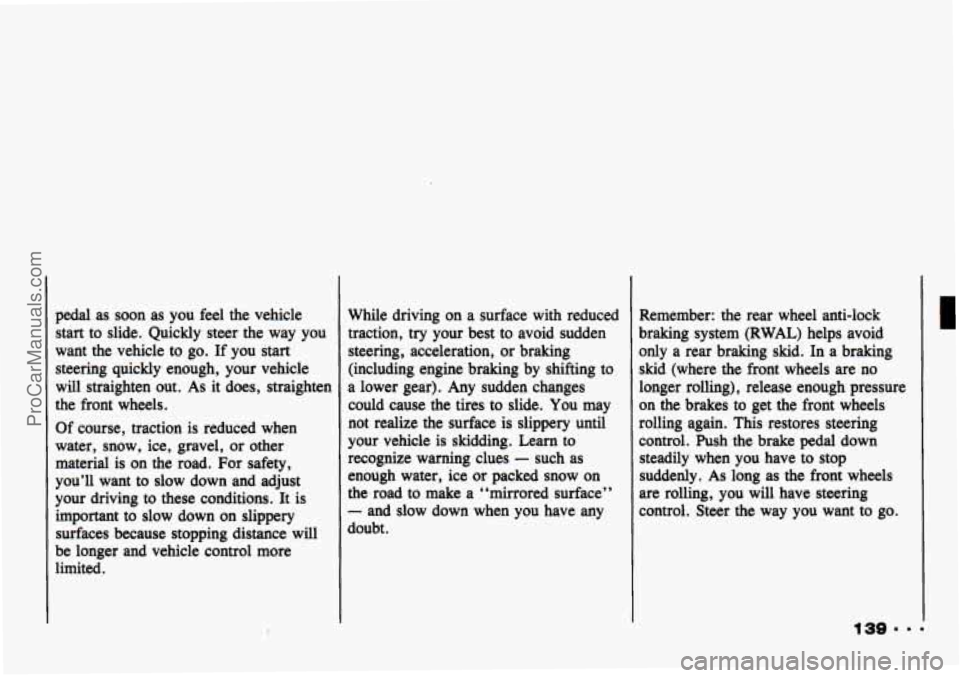
pedal as soon as you feel the vehicle
start to slide. Quickly steer the way you
want the vehicle to go. If you start
steering quickly enough, your vehicle
will straighten out. As
it does, straighten
the front wheels.
Of course, traction is reduced when
water, snow, ice, gravel, or other
material is
on the road. For safety,
you’ll want to slow down and adjust
your driving to these conditions. It is
important to slow down
on slippery
surfaces because stopping distance
will
be longer and vehicle control more
limited. While
driving on a surface with reduced
traction,
try your best to avoid sudden
steering, acceleration, or braking
(including engine braking by shifting to
a lower gear). Any sudden changes
could cause the tires to slide.
You may
not realize the surface
is slippery until
your vehicle is skidding. Learn to
recognize warning clues
- such as
enough water, ice
or packed snow on
the. road to make a “mirrored surface’’
- and slow down when you have any
doubt. Remember: the
rear wheel anti-lock
braking system (RWAL) helps avoid
only a rear braking skid. In a braking
skid (where the front wheels are no
longer rolling), release enough pressure
on the brakes to get the front wheels
rolling again. This restores steering
control. Push the brake pedal down
steadily when you have to stop
suddenly. As long as the front wheels
are rolling, you will have steering
control. Steer the way you want to go.
ProCarManuals.com
Page 142 of 339
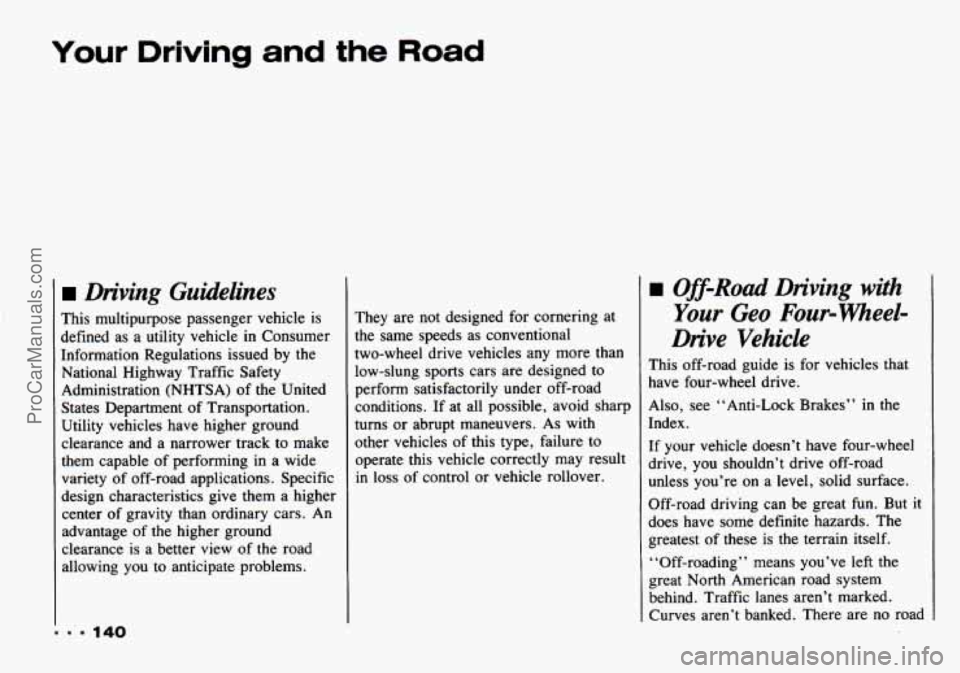
Your Driving and the Road
Driving Guidelines
... 140
This multipurpose passenger vehicle is
defined as a utility vehicle in Consumer
Information Regulations issued by the
National Highway Traffic Safety
Administration (NHTSA) of the United
States Department of Transportation.
Utility vehicles have higher ground
clearance and a narrower track to make
them capable of performing in a wide
variety of off-road applications. Specific
design characteristics give them a higher
center of gravity than ordinary cars. An
advantage
of the higher ground
clearance
is a better view of the road
allowing you to anticipate problems. They
are not designed for cornering at
the same speeds as conventional
two-wheel drive vehicles any more than
low-slung sports cars are designed to
perform satisfactorily under off-road
conditions. If at all possible, avoid sharp
turns or abrupt maneuvers. As with
other vehicles of this type, failure to
operate this vehicle correctly may result
in
loss of control or vehicle rollover.
1 Off-Road Driving with
Your Geo Four-Wheel-
Drive Vehicle
This off-road guide is for vehicles that
have four-wheel drive.
Also, see “Anti-Lock Brakes” in the
Index.
If your vehicle doesn’t have four-wheel
drive, you shouldn’t drive off-road
unless you’re on a level, solid surface.
Off-road driving can be great
fun. But it
does have some definite hazards. The
greatest of these is the terrain itself.
“Off-roading” means you’ve left the
great North American road system
behind. Traffic lanes aren’t marked.
Curves aren’t banked. There are no road
ProCarManuals.com
Page 143 of 339
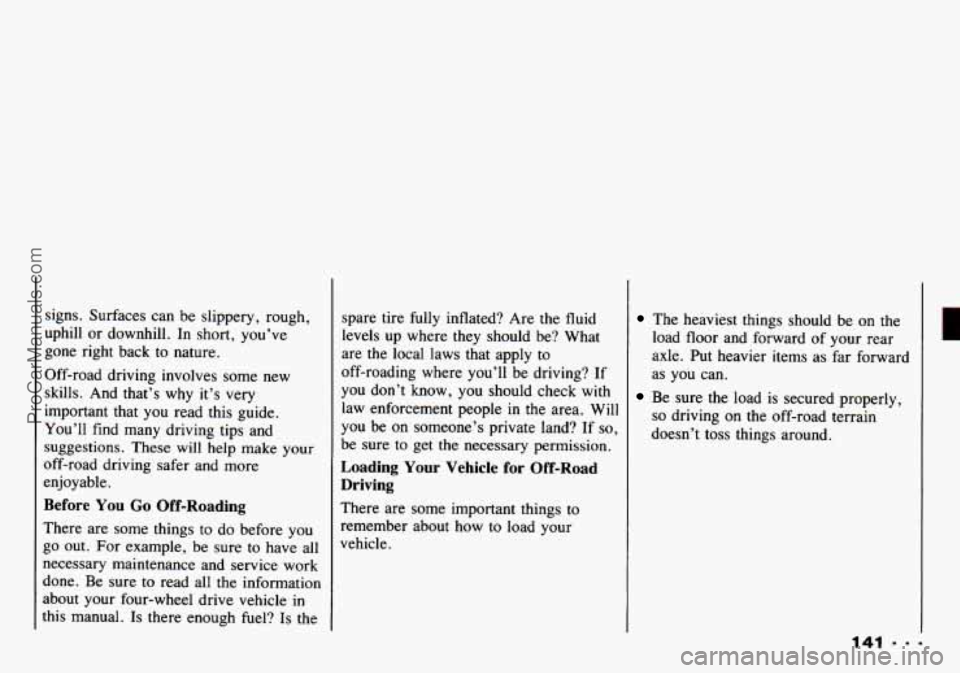
signs. Surfaces can be slippery, rough,
uphill or downhill. In short, you’ve
gone right back to nature.
Off-road driving involves some new
skills. And that’s why
it’s very
important that you read this guide.
You’ll find many driving tips and
suggestions. These will help make your
off-road driving safer and more
enjoyable.
Before You Go Off-Roading
There are some things to do before you
go out. For example, be sure to have all
necessary maintenance and service work
done. Be sure
to read all the information
about your four-wheel drive vehicle in
this manual.
Is there enough fuel? Is the spare
tire fully inflated? Are the fluid
levels up where they should be? What
are the local laws that apply to
off-roading where you’ll be driving? If
you don’t
know, you should check with
law enforcement people in the area. Wil
you be on someone’s private land?
If so
be sure to get the necessary permission.
Loading Your Vehicle for Off-Road
Driving
There are some important things to
remember about how to load your
vehicle.
The heaviest things should be on the
load floor and forward of your rear
axle. Put heavier items as far forward
as you can.
Be sure the load is secured properly,
so driving on the off-road terrain
doesn’t
toss things around.
ProCarManuals.com
Page 144 of 339
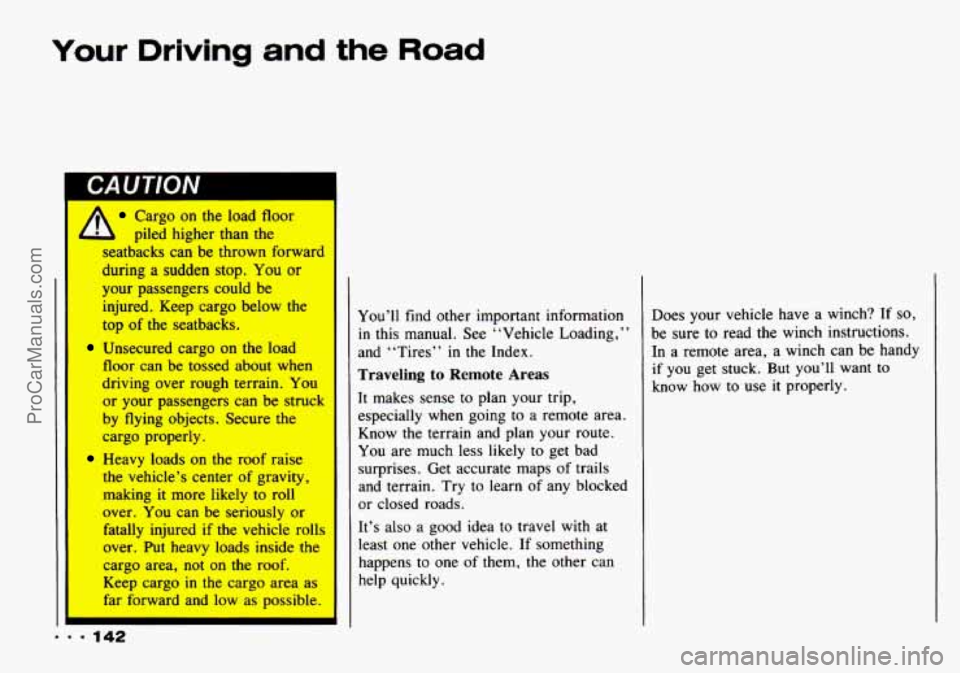
Your Driving and the Road
A Cargo on the load floor
L piled higher than the
seatbacks can be thrown forwarc
during a sudden stop. You or
your passengers could be
injured. Keep cargo below the
top of the seatbacks.
floor can be tossed about when
driving over rough terrain. You
or your passengers can be strucl
by flying objects. Secure the
cargo properly.
Heavy loads on the roof raise
the vehicle’s center of gravity,
making it more likely to roll
over. You can be seriously or
fatally injured if the vehicle rolls
over. Put heavy loads inside the
cargo area, not on the roof.
Keep cargo
in the cargo area as
far forward and low as possible.
Unsecured cargo on the load
I
You’ll find other important information
in this manual. See “Vehicle Loading,”
and “Tires” in the Index.
Traveling to Remote Areas
It makes sense to plan your trip,
especially when going to a remote area.
Know the terrain and plan your route.
You are much less likely to get bad
surprises. Get accurate maps
of trails
and terrain.
Try to learn of any blocked
or closed roads.
It’s also
a good idea to travel with at
least one other vehicle.
If something
happens to one of them,
the other can
help quickly. Does
your vehicle have a winch? If
so,
be sure to read the winch instructions.
In a remote area, a winch can be handy
if you get stuck. But you’ll want to
know how to use it properly.
... 142
ProCarManuals.com
Page 145 of 339
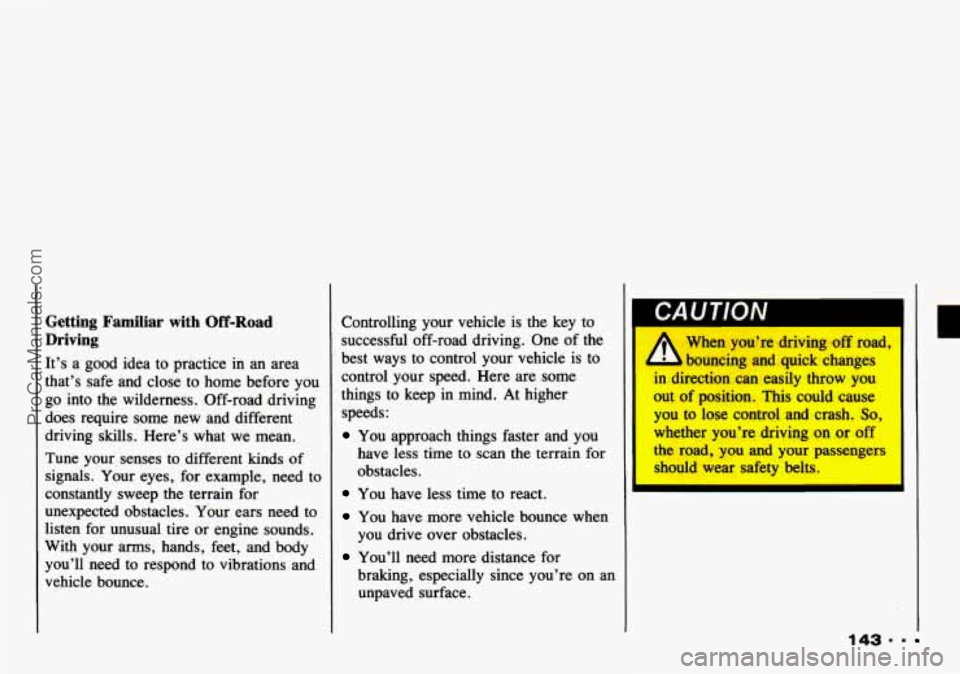
Getting Familiar with Off-Road
Driving
It’s a good idea to practice in an area
that’s safe and close
to home before you
go into the wilderness. Off-road driving
does require some new and different
driving skills. Here’s what we mean.
Tune your senses to different kinds of
signals. Your eyes, for example, need to
constantly sweep the terrain for
unexpected obstacles. Your ears need
to
listen for unusual tire or engine sounds.
With your arms, hands, feet, and body
you’ll need to respond to vibrations and
vehicle bounce.
I.
best ways to control your vehicle is to
control your speed. Here are some
things to keep in mind. At higher
speeds:
You approach things faster and you
have less time
to scan the terrain for
obstacles.
You have less time to react.
You have more vehicle bounce when
you drive over obstacles.
You’ll need more distance for
braking, especially since you’re on an
unpaved surface.
CAUTION Controlling your vehicle is the key to
successful off-road driving. One of the When you’re driving
off road,
c L bouncing and quick changes
in direction can easily throw you
out
of position. This could cause
you to lose control and crash.
So,
whether you’re driving on or off
the road, you and your passengers
should wear safety belts.
r
143- -
ProCarManuals.com
Page 146 of 339
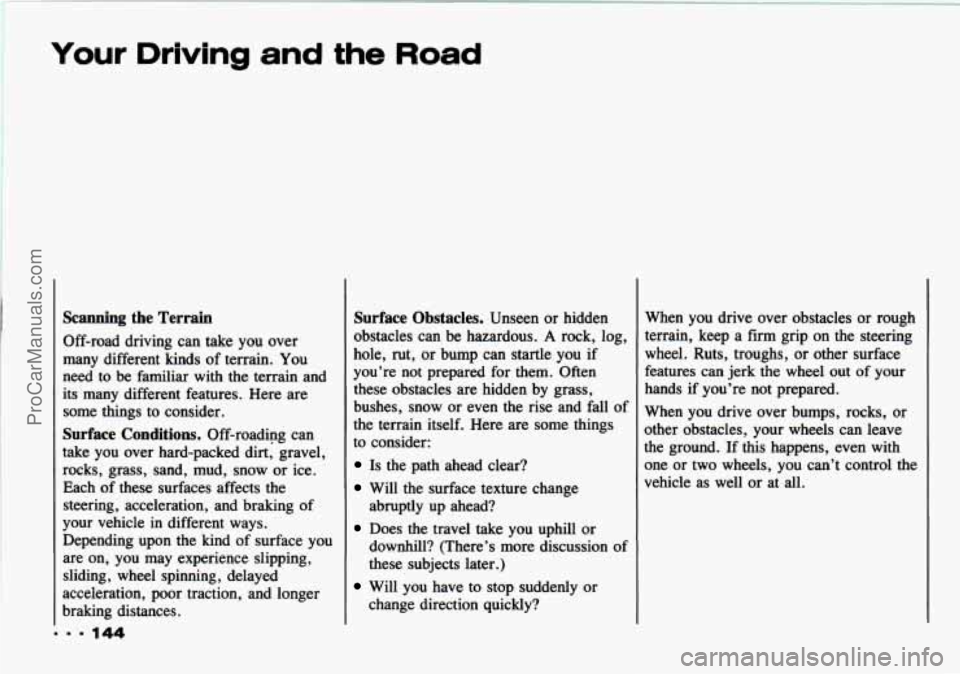
Your Driving and the Road
... 144
Scanning the Terrain
Off-road driving can take you over
many different kinds of terrain. You
need to be familiar with the terrain and
its many different features. Here
are
some things to consider.
Surface Conditions. Off-roading can
take you over hard-packed dirt; gravel,
rocks, grass, sand, mud, snow or ice.
Each
of these surfaces affects the
steering, acceleration, and braking of
your vehicle in different ways.
Depending upon the kind of surface you
are
on, you may experience slipping,
sliding,
wheel spinning, delayed
acceleration, poor traction. and longer
braking distanc
Surface Obstacles. Unseen or hidden
obstacles can be hazardous.
A rock, log,
hole, rut, or bump can startle
you if
you’re not prepared for them. Often
these obstacles
are hidden by grass,
bushes, snow or even the rise and fall of
the terrain itself. Here are some things
to consider:
Is the path ahead clear?
Will the surface texture change
Does the travel take you uphill or
abruptly up ahead?
downhill? (There’s
more discussion of
these subjects later.)
change direction quickly?
Will you have to stop suddenly or When you
drive over obstacles or rough
terrain, keep
a firm grip on the steering
wheel. Ruts, troughs, or other surface
features can jerk the wheel out of your
hands if you’re not prepared.
When you drive over bumps, rocks, or
other obstacles,
your wheels can leave
the ground.
If this happens, even with
one or two wheels, you can’t control the
vehicle as well or at
all.
ProCarManuals.com
Page 147 of 339
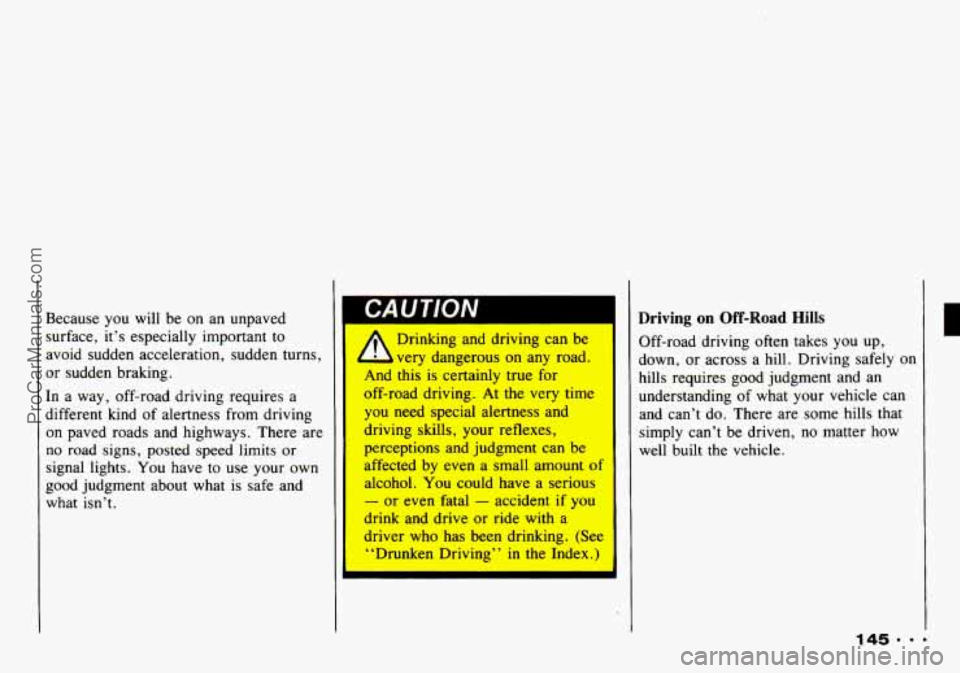
Because you will be on an unpaved
I
surface, it’s especially important to
avoid sudden acceleration, sudden turns,
or sudden braking.
In a way, off-road driving requires a
different kind
of alertness from driving
on paved roads and highways. There are
no road signs, posted speed limits or
signal lights. You have to use your own
good judgment about what is safe and
what isn’t.
I CAUTION
’ Drinking and driving can be
- very dangerous on any road.
And this is certainly true for
off-road driving. At the very time
you need special alertness and
driving skills, your reflexes,
perceptions and judgment can be
affected by even a small amount
of
alcohol. You could have a serious
- or even fatal - accident if you
drink and drive or ride with a
driver who has been drinking. (See
“Drunken Driving” in the Index.)
Driving on Off-Road Hills
Off-road driving often takes you up,
down, or across a hill. Driving safely on
hills requires good judgment and an
understanding of what your vehicle can
and can’t do. There are some hills that
simply can’t be driven, no matter how
well built the vehicle.
ProCarManuals.com
Page 148 of 339
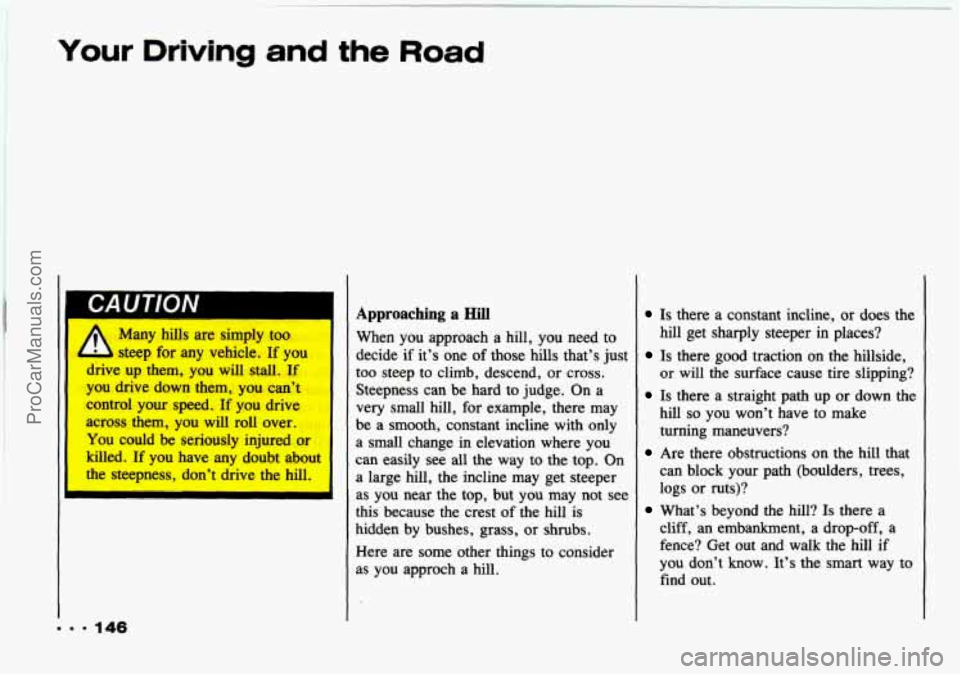
Your Driving and the load
1 CAUTION
1 Many hills are simply too I
- steep for any vehicle. If you
drive up them,
you will stall. If
you drive down them, you can’t
control your speed. If you drive
across them, you will
roll over.
You could be seriously injured or
killed. If you have any doubt about
the steepness, don’t drive the hill.
Approaching a Hill
When you approach a hill, you need to
decide if it’s one of those hills that’s just
too steep to climb, descend,
or cross.
Steepness can be hard
to judge. On a
very small hill,
for example, there may
be a smooth, constant incline with only
a small change in elevation where you
can easily see all the way to the top. On
a large hill, the incline may get steeper
as
you near the top, but you may not see
this because the crest of the hill is
hidden by bushes,
grass, or shrubs.
Here are some other things to consider
as you approch a hill.
Is there a constant incline, or does the
hill get sharply steeper
in places?
Is there good traction on the hillside,
or will the surface cause tire slipping?
Is there a straight path up or down the
hill
so you won’t have to make
turning maneuvers?
Are there obstructions on the hill that
can block your path (boulders, trees,
logs
or ruts)?
What’s beyond the hill? Is there a
cliff, an embankment, a drop-off, a
fence? Get out and walk the hill if
you don’t know. It’s the smart way to
find out.
ProCarManuals.com
Page 149 of 339
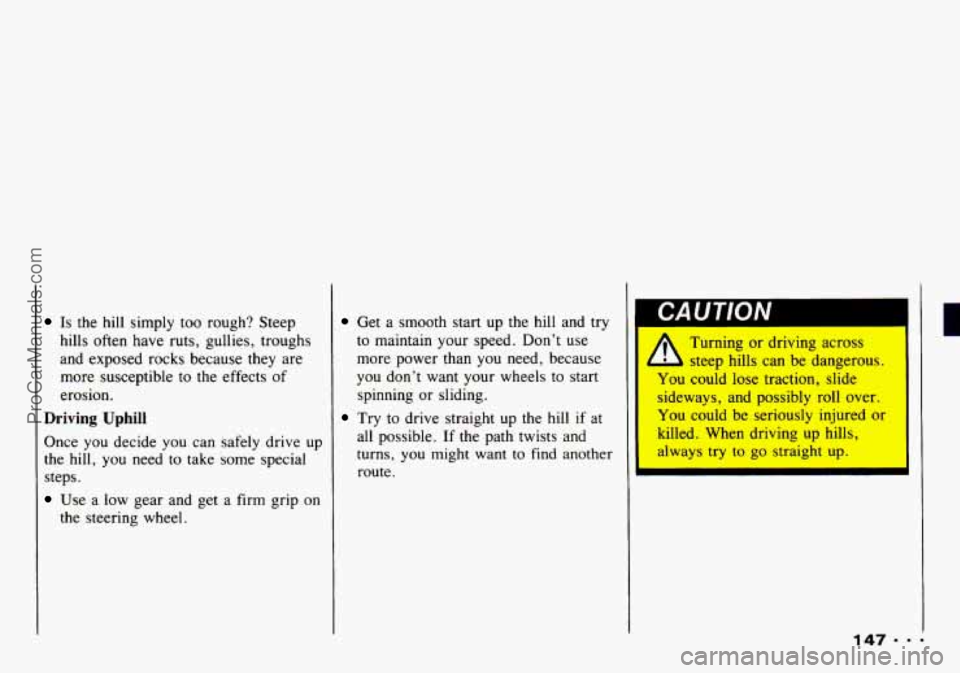
Is the hill simply too rough? Steep
hills often have ruts, gullies, troughs
and exposed rocks because they are
more susceptible to
the effects of
erosion.
Driving Uphill
Once you decide you can safely drive up
the hill, you need to take some special
steps.
Use a low gear and get a firm grip on
the steering wheel.
Get a smooth start up the hill and try
to maintain your speed. Don’t use
more power than you need, because
you don’t want your wheels to start
spinning or sliding.
Try to drive straight up the hill if at
all possible. If the path twists and
turns, you might want to find another
route.
CAUTION
A
Turning or driving across
steep hills can be dangerous.
You could lose traction, slide
sideways, and possibly roll over.
You could be seriously injured or
killed. When driving
up hills,
always
try to go straight up.
ProCarManuals.com
Page 150 of 339
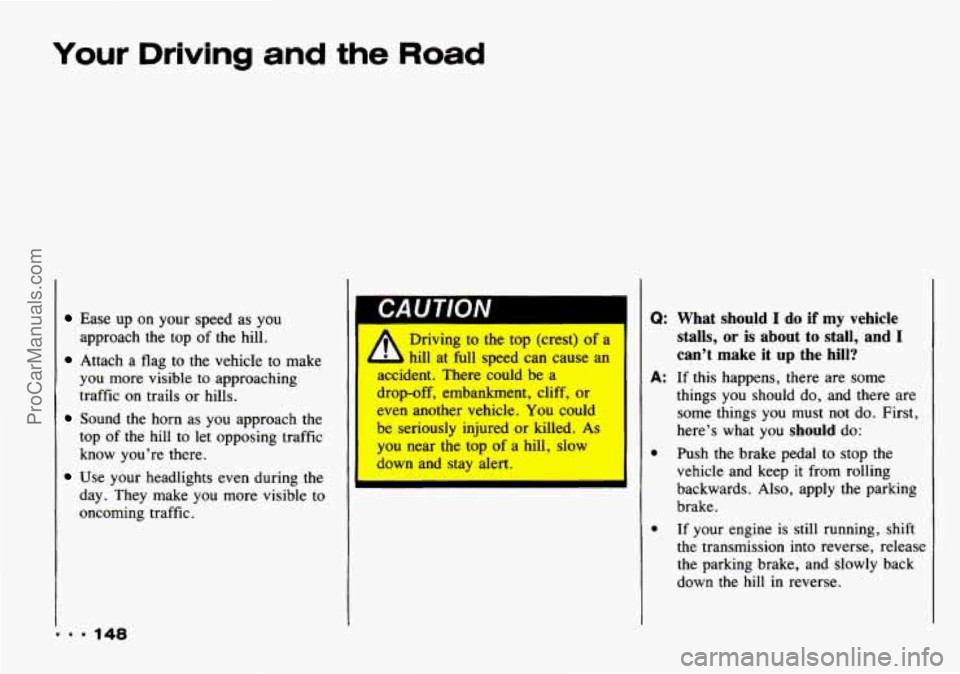
Your Driving and the Road
Ease up on your speed as you
approach the top
of the hill.
Attach a flag to the vehicle to make
you more visible to approaching
traffic on trails or hills.
Sound the horn as you approach the
top of the hill to let opposing traffic
know you’re there.
Use your headlights even during the
day. They make you more visible to
oncoming traffic.
CAUTION
A Driving to the top (crest) of a
hill at full speed can cause an
accident. There could be a
drop-off, embankment, cliff, or
even another vehicle. You could
be seriously injured or killed. As
you near the top of a hill, slow
down and stay alert.
I
Q: What should I do if my vehicle
stalls,
or is about to stall, and I
can’t make it up the hill?
A: If this happens, there are some
things you-should do, and there are
some things you must not do. First,
here’s what you
should do:
Push the brake pedal to stop
the
vehicle and keep it from rolling
backwards. Also, apply the parking
brake.
If your engine is still running, shift
the transmission into reverse, release
the parking brake, and slowly back
down the hill in reverse.
ProCarManuals.com